Natural Monopoly: Efficiency, Pricing, and Regulatory Frameworks
VerifiedAdded on 2020/02/19
|11
|2776
|58
Essay
AI Summary
This essay provides a comprehensive analysis of natural monopolies, beginning with an introduction to the concept and its implications in terms of market power and resource allocation. It differentiates natural monopolies from competitive markets, highlighting inefficiencies like deadweight loss. The essay then delves into the unique characteristics of natural monopolies, where a single firm can operate at decreasing average total costs, often seen in public utilities. It explores pricing strategies, including unregulated monopoly pricing, socially optimal pricing, and average pricing, evaluating the advantages and disadvantages of each. The discussion extends to regulatory approaches, contrasting cost-plus and price cap regulations, and analyzing their impact on efficiency, innovation, and consumer welfare. The essay concludes by emphasizing the importance of appropriate regulatory frameworks in balancing the benefits of economies of scale with the need to protect consumers from potential exploitation by monopolists.

Running head: NATURAL MONOPOLY
Natural Monopoly
Name of the Student
Name of the University
Author note
Natural Monopoly
Name of the Student
Name of the University
Author note
Paraphrase This Document
Need a fresh take? Get an instant paraphrase of this document with our AI Paraphraser

1NATURAL MONOPOLY
Introduction
Monopoly is a market where single seller captures the entire market share. Because of
maximum market power the monopolist always, exploit resources. In a monopoly market
resource allocation and distribution is not done in an efficient manner. There is always a
deadweight loss in the resulting market. However, there are situation where presence of a single
business firm leads to economies of scale and hence, is best in terms of efficiency in allocation.
Such a market is called natural monopoly. It might happen that one firm is able to operate at the
decreasing part of average total cost and still satisfies market demand. This is the situation where
the production process entails a high fixed cost compared to the variable cost. This is described
as the situation of natural monopoly. Dividing natural monopoly market results in rising average
cost and hence a higher price in the market.
Mostly public utilities such as water service, electricity service are examples of natural
monopoly. Natural monopoly possesses a dilemma in public policy designing. Because of
presence of economies of scale, natural monopoly entails productive efficiency. If entry is
allowed in the market then consumers suffers with a high price. Being a sole supplier in the
market the monopoly might be tempted to exploit its monopoly power and earn a higher profit.
Therefore, such an unregulated monopoly causes concern.
Comparison between monopoly and perfect competition
In a perfectly competitive market, there are several sellers and buyers participating in the
exchange process. The equilibrium of a single firm occurs at a point where price equals marginal
cost in the short run and in the long run price is set at the minimum point of average total cost
leaving only normal profit for the firms presents in the industry (Lim & Yurukoglu, 2015). The
Introduction
Monopoly is a market where single seller captures the entire market share. Because of
maximum market power the monopolist always, exploit resources. In a monopoly market
resource allocation and distribution is not done in an efficient manner. There is always a
deadweight loss in the resulting market. However, there are situation where presence of a single
business firm leads to economies of scale and hence, is best in terms of efficiency in allocation.
Such a market is called natural monopoly. It might happen that one firm is able to operate at the
decreasing part of average total cost and still satisfies market demand. This is the situation where
the production process entails a high fixed cost compared to the variable cost. This is described
as the situation of natural monopoly. Dividing natural monopoly market results in rising average
cost and hence a higher price in the market.
Mostly public utilities such as water service, electricity service are examples of natural
monopoly. Natural monopoly possesses a dilemma in public policy designing. Because of
presence of economies of scale, natural monopoly entails productive efficiency. If entry is
allowed in the market then consumers suffers with a high price. Being a sole supplier in the
market the monopoly might be tempted to exploit its monopoly power and earn a higher profit.
Therefore, such an unregulated monopoly causes concern.
Comparison between monopoly and perfect competition
In a perfectly competitive market, there are several sellers and buyers participating in the
exchange process. The equilibrium of a single firm occurs at a point where price equals marginal
cost in the short run and in the long run price is set at the minimum point of average total cost
leaving only normal profit for the firms presents in the industry (Lim & Yurukoglu, 2015). The

2NATURAL MONOPOLY
equilibrium in the industry is obtained at the point of intersection between the industry demand
and supply curve.
The situation is different in a monopoly market. There are no difference between firm
and industry in a monopoly market. The industry supply curve becomes marginal cost curve for
the monopolist. The monopolist set it price where marginal revenue equals marginal cost. The
resulted price and quantity in the monopoly market is inefficient in comparison to the
competitive market. It is seen that the monopolist sells a lower quantity at a high price as
compared to competitive firm (Stiglitz & Rosengard, 2015). This results in loss of welfare to the
society known as deadweight loss. This is explained in the following figure.
Figure 1: Monopoly and competitive market
(Source: As created by Author)
equilibrium in the industry is obtained at the point of intersection between the industry demand
and supply curve.
The situation is different in a monopoly market. There are no difference between firm
and industry in a monopoly market. The industry supply curve becomes marginal cost curve for
the monopolist. The monopolist set it price where marginal revenue equals marginal cost. The
resulted price and quantity in the monopoly market is inefficient in comparison to the
competitive market. It is seen that the monopolist sells a lower quantity at a high price as
compared to competitive firm (Stiglitz & Rosengard, 2015). This results in loss of welfare to the
society known as deadweight loss. This is explained in the following figure.
Figure 1: Monopoly and competitive market
(Source: As created by Author)
⊘ This is a preview!⊘
Do you want full access?
Subscribe today to unlock all pages.

Trusted by 1+ million students worldwide
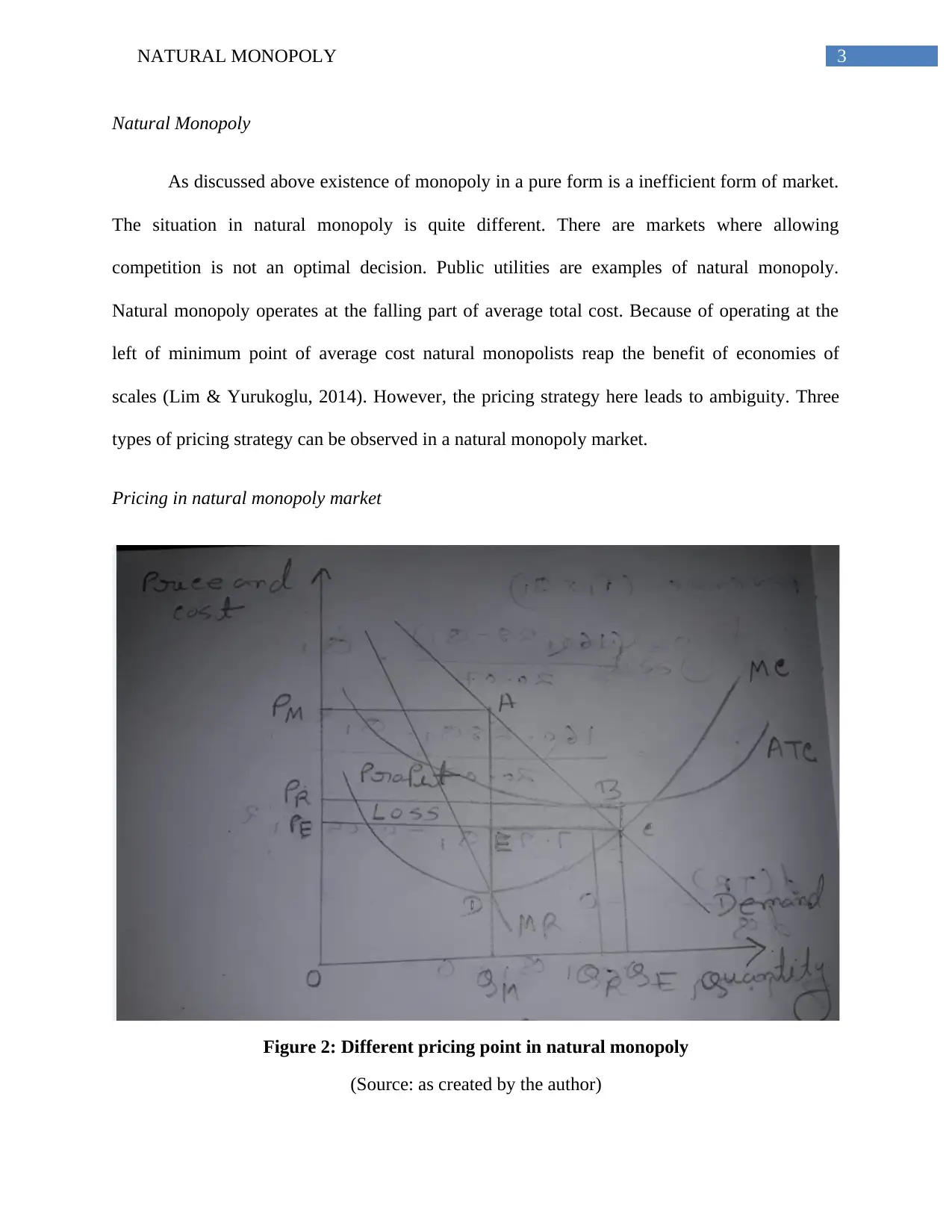
3NATURAL MONOPOLY
Natural Monopoly
As discussed above existence of monopoly in a pure form is a inefficient form of market.
The situation in natural monopoly is quite different. There are markets where allowing
competition is not an optimal decision. Public utilities are examples of natural monopoly.
Natural monopoly operates at the falling part of average total cost. Because of operating at the
left of minimum point of average cost natural monopolists reap the benefit of economies of
scales (Lim & Yurukoglu, 2014). However, the pricing strategy here leads to ambiguity. Three
types of pricing strategy can be observed in a natural monopoly market.
Pricing in natural monopoly market
Figure 2: Different pricing point in natural monopoly
(Source: as created by the author)
Natural Monopoly
As discussed above existence of monopoly in a pure form is a inefficient form of market.
The situation in natural monopoly is quite different. There are markets where allowing
competition is not an optimal decision. Public utilities are examples of natural monopoly.
Natural monopoly operates at the falling part of average total cost. Because of operating at the
left of minimum point of average cost natural monopolists reap the benefit of economies of
scales (Lim & Yurukoglu, 2014). However, the pricing strategy here leads to ambiguity. Three
types of pricing strategy can be observed in a natural monopoly market.
Pricing in natural monopoly market
Figure 2: Different pricing point in natural monopoly
(Source: as created by the author)
Paraphrase This Document
Need a fresh take? Get an instant paraphrase of this document with our AI Paraphraser

4NATURAL MONOPOLY
Unregulated natural monopoly
In a natural monopoly market, the single supplier can behave like a pure monopolist if the
market left unregulated. Here, the monopolist set its price by following standard profit
maximization condition. The profit maximizing condition indicates price and quantity where
marginal revenue and marginal cost curve cut each other. In an unregulated situation profit
maximizing monopolist would chose this point at an optimum equilibrium point (Kirzner, 2015).
‘A’ denotes the point where the natural monopolist operate in the absence of regulation.
The profit maximizing price is shown in the above figure is shown as PM. It is obtained
corresponding to the point where marginal revenue cuts marginal cost curve.
Optimal pricing for society
Condition of a competitive form of market is most efficient for the society. The
competitive firm set its price at a point where is equalizes with marginal cost. It is called the
efficient pricing (Foster, 2014).
Point ‘C’ shows the socially optimum point. PE is the socially efficient price. Corresponding to
this the optimum quantity is QE. Price in the efficient condition is less than that that under profit
maximization condition. The situation is different from the competitive market. In the
competitive market firms operates at the minimum point of average cost. In the natural
monopoly, firm operates at the falling part of average cost curve. Hence, natural monopolist fails
to recover average cost of production. It the monopolist set its price at his level then a loss will
be realized. The loss is indicated by the area of the rectangle PRBCPE.
Unregulated natural monopoly
In a natural monopoly market, the single supplier can behave like a pure monopolist if the
market left unregulated. Here, the monopolist set its price by following standard profit
maximization condition. The profit maximizing condition indicates price and quantity where
marginal revenue and marginal cost curve cut each other. In an unregulated situation profit
maximizing monopolist would chose this point at an optimum equilibrium point (Kirzner, 2015).
‘A’ denotes the point where the natural monopolist operate in the absence of regulation.
The profit maximizing price is shown in the above figure is shown as PM. It is obtained
corresponding to the point where marginal revenue cuts marginal cost curve.
Optimal pricing for society
Condition of a competitive form of market is most efficient for the society. The
competitive firm set its price at a point where is equalizes with marginal cost. It is called the
efficient pricing (Foster, 2014).
Point ‘C’ shows the socially optimum point. PE is the socially efficient price. Corresponding to
this the optimum quantity is QE. Price in the efficient condition is less than that that under profit
maximization condition. The situation is different from the competitive market. In the
competitive market firms operates at the minimum point of average cost. In the natural
monopoly, firm operates at the falling part of average cost curve. Hence, natural monopolist fails
to recover average cost of production. It the monopolist set its price at his level then a loss will
be realized. The loss is indicated by the area of the rectangle PRBCPE.
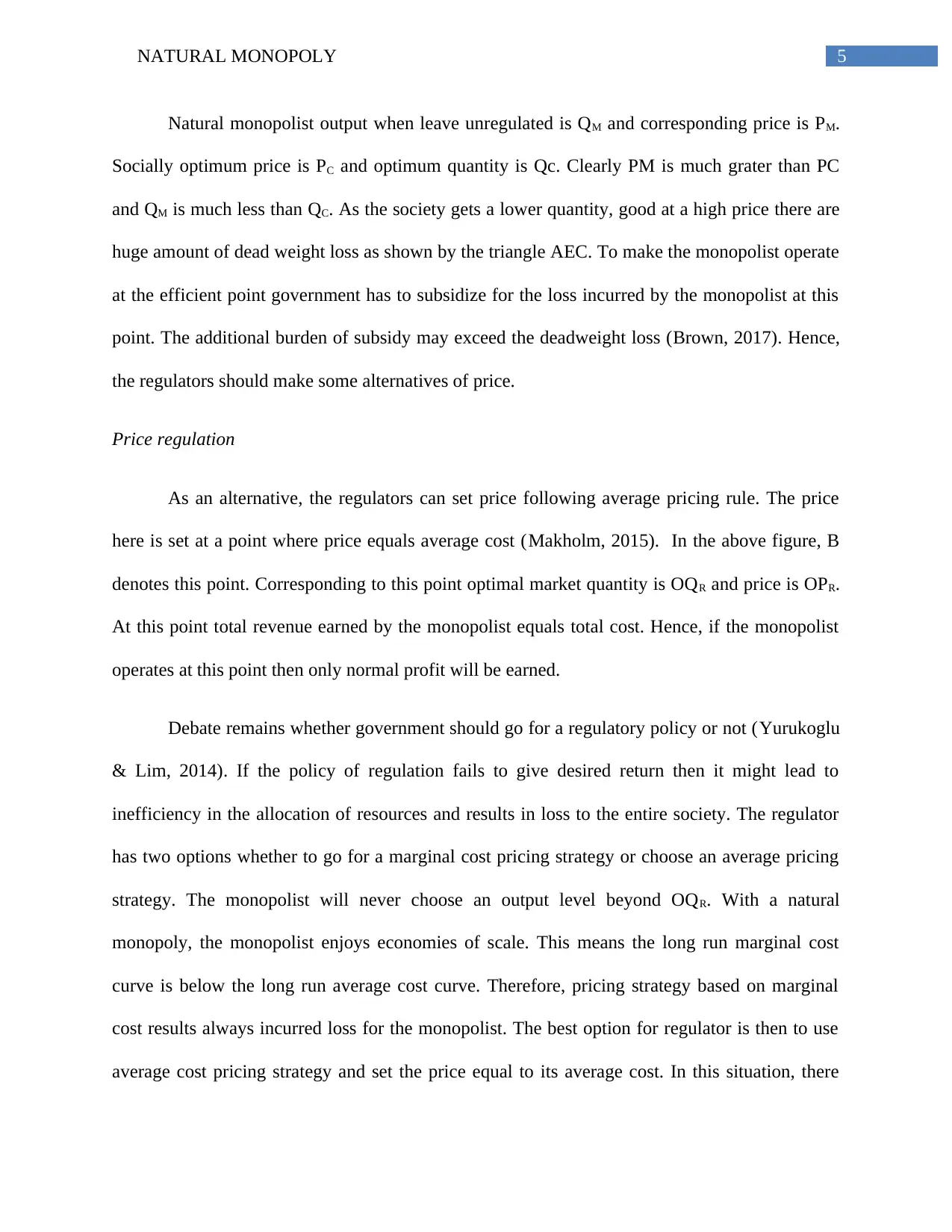
5NATURAL MONOPOLY
Natural monopolist output when leave unregulated is QM and corresponding price is PM.
Socially optimum price is PC and optimum quantity is Qc. Clearly PM is much grater than PC
and QM is much less than QC. As the society gets a lower quantity, good at a high price there are
huge amount of dead weight loss as shown by the triangle AEC. To make the monopolist operate
at the efficient point government has to subsidize for the loss incurred by the monopolist at this
point. The additional burden of subsidy may exceed the deadweight loss (Brown, 2017). Hence,
the regulators should make some alternatives of price.
Price regulation
As an alternative, the regulators can set price following average pricing rule. The price
here is set at a point where price equals average cost (Makholm, 2015). In the above figure, B
denotes this point. Corresponding to this point optimal market quantity is OQR and price is OPR.
At this point total revenue earned by the monopolist equals total cost. Hence, if the monopolist
operates at this point then only normal profit will be earned.
Debate remains whether government should go for a regulatory policy or not (Yurukoglu
& Lim, 2014). If the policy of regulation fails to give desired return then it might lead to
inefficiency in the allocation of resources and results in loss to the entire society. The regulator
has two options whether to go for a marginal cost pricing strategy or choose an average pricing
strategy. The monopolist will never choose an output level beyond OQR. With a natural
monopoly, the monopolist enjoys economies of scale. This means the long run marginal cost
curve is below the long run average cost curve. Therefore, pricing strategy based on marginal
cost results always incurred loss for the monopolist. The best option for regulator is then to use
average cost pricing strategy and set the price equal to its average cost. In this situation, there
Natural monopolist output when leave unregulated is QM and corresponding price is PM.
Socially optimum price is PC and optimum quantity is Qc. Clearly PM is much grater than PC
and QM is much less than QC. As the society gets a lower quantity, good at a high price there are
huge amount of dead weight loss as shown by the triangle AEC. To make the monopolist operate
at the efficient point government has to subsidize for the loss incurred by the monopolist at this
point. The additional burden of subsidy may exceed the deadweight loss (Brown, 2017). Hence,
the regulators should make some alternatives of price.
Price regulation
As an alternative, the regulators can set price following average pricing rule. The price
here is set at a point where price equals average cost (Makholm, 2015). In the above figure, B
denotes this point. Corresponding to this point optimal market quantity is OQR and price is OPR.
At this point total revenue earned by the monopolist equals total cost. Hence, if the monopolist
operates at this point then only normal profit will be earned.
Debate remains whether government should go for a regulatory policy or not (Yurukoglu
& Lim, 2014). If the policy of regulation fails to give desired return then it might lead to
inefficiency in the allocation of resources and results in loss to the entire society. The regulator
has two options whether to go for a marginal cost pricing strategy or choose an average pricing
strategy. The monopolist will never choose an output level beyond OQR. With a natural
monopoly, the monopolist enjoys economies of scale. This means the long run marginal cost
curve is below the long run average cost curve. Therefore, pricing strategy based on marginal
cost results always incurred loss for the monopolist. The best option for regulator is then to use
average cost pricing strategy and set the price equal to its average cost. In this situation, there
⊘ This is a preview!⊘
Do you want full access?
Subscribe today to unlock all pages.

Trusted by 1+ million students worldwide

6NATURAL MONOPOLY
will be no excess profit (Carvalho & Marques, 2014). Here, only profit is realized that is a part of
cost.
Price cap regulation versus Cost plus regulation
Regulators attempt to choose a regulation point like by equalizing price with marginal
cost. In order to implement the strategy the regulators use a simple and general approach. They
first compute the average production cost of natural monopoly companies like electricity or
water companies. In the cost calculation, they include the normal profit rate (Simshauser, 2017).
The normal profit is included in order to ensure the fact that the monopolists able to earn a
normal profit after the regulation. After calculation of cost, price is determined accordingly. The
process of regulating price in this method is called cost plus regulation.
Though the method is simple but is has its own shortcoming. The monopoly seller can
reimburse for the cost accounted in the production process. The producer gives less care to the
issue of high cost. Because the monopolist knows that, the burden of high cost can be pass to the
consumers by charging a high price. The regulation through cost plus technique lacks efficiency.
It cannot efficiently choose the minimum price for the society (Basso, Figueroa & Vásquez,
2017). Once price regulation is undertaken through cost plus method then the monopolist has a
tendency to overstate its cost. If the right cost figures are not disclosed then it is not possible to
efficiently set the price. There is another factor to be considered here. When price is set equal to
its average total cost then the producer lose all initiatives for reducing its production cost. In an
unregulated market monopolists tries to minimize cost at least as possible to maximize profit. In
fact, in the regulated market monopolist can engage in practice that unnecessarily increase total
cost and hence average cost (Puller, 2013). Here, the monopolist can employ a large number of
will be no excess profit (Carvalho & Marques, 2014). Here, only profit is realized that is a part of
cost.
Price cap regulation versus Cost plus regulation
Regulators attempt to choose a regulation point like by equalizing price with marginal
cost. In order to implement the strategy the regulators use a simple and general approach. They
first compute the average production cost of natural monopoly companies like electricity or
water companies. In the cost calculation, they include the normal profit rate (Simshauser, 2017).
The normal profit is included in order to ensure the fact that the monopolists able to earn a
normal profit after the regulation. After calculation of cost, price is determined accordingly. The
process of regulating price in this method is called cost plus regulation.
Though the method is simple but is has its own shortcoming. The monopoly seller can
reimburse for the cost accounted in the production process. The producer gives less care to the
issue of high cost. Because the monopolist knows that, the burden of high cost can be pass to the
consumers by charging a high price. The regulation through cost plus technique lacks efficiency.
It cannot efficiently choose the minimum price for the society (Basso, Figueroa & Vásquez,
2017). Once price regulation is undertaken through cost plus method then the monopolist has a
tendency to overstate its cost. If the right cost figures are not disclosed then it is not possible to
efficiently set the price. There is another factor to be considered here. When price is set equal to
its average total cost then the producer lose all initiatives for reducing its production cost. In an
unregulated market monopolists tries to minimize cost at least as possible to maximize profit. In
fact, in the regulated market monopolist can engage in practice that unnecessarily increase total
cost and hence average cost (Puller, 2013). Here, the monopolist can employ a large number of
Paraphrase This Document
Need a fresh take? Get an instant paraphrase of this document with our AI Paraphraser
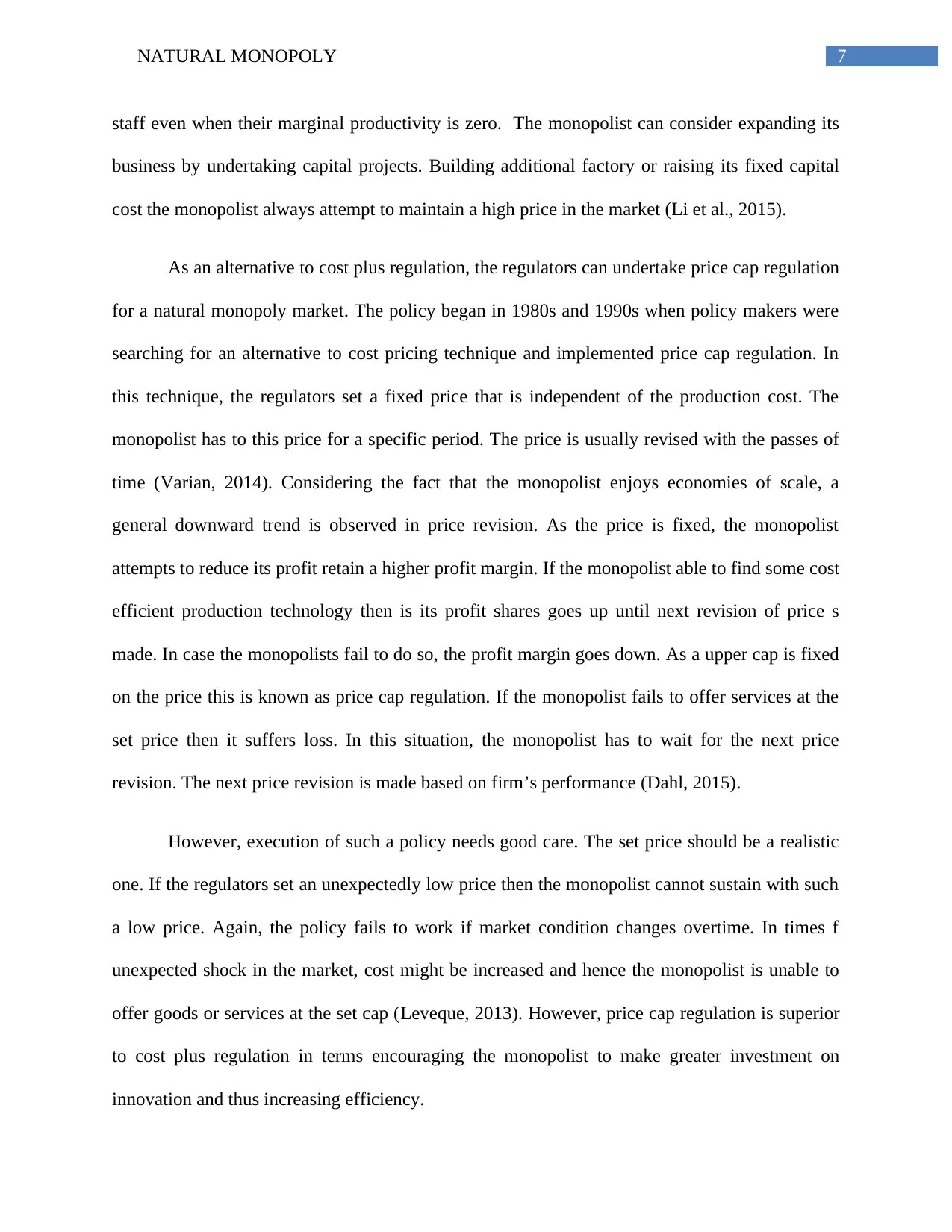
7NATURAL MONOPOLY
staff even when their marginal productivity is zero. The monopolist can consider expanding its
business by undertaking capital projects. Building additional factory or raising its fixed capital
cost the monopolist always attempt to maintain a high price in the market (Li et al., 2015).
As an alternative to cost plus regulation, the regulators can undertake price cap regulation
for a natural monopoly market. The policy began in 1980s and 1990s when policy makers were
searching for an alternative to cost pricing technique and implemented price cap regulation. In
this technique, the regulators set a fixed price that is independent of the production cost. The
monopolist has to this price for a specific period. The price is usually revised with the passes of
time (Varian, 2014). Considering the fact that the monopolist enjoys economies of scale, a
general downward trend is observed in price revision. As the price is fixed, the monopolist
attempts to reduce its profit retain a higher profit margin. If the monopolist able to find some cost
efficient production technology then is its profit shares goes up until next revision of price s
made. In case the monopolists fail to do so, the profit margin goes down. As a upper cap is fixed
on the price this is known as price cap regulation. If the monopolist fails to offer services at the
set price then it suffers loss. In this situation, the monopolist has to wait for the next price
revision. The next price revision is made based on firm’s performance (Dahl, 2015).
However, execution of such a policy needs good care. The set price should be a realistic
one. If the regulators set an unexpectedly low price then the monopolist cannot sustain with such
a low price. Again, the policy fails to work if market condition changes overtime. In times f
unexpected shock in the market, cost might be increased and hence the monopolist is unable to
offer goods or services at the set cap (Leveque, 2013). However, price cap regulation is superior
to cost plus regulation in terms encouraging the monopolist to make greater investment on
innovation and thus increasing efficiency.
staff even when their marginal productivity is zero. The monopolist can consider expanding its
business by undertaking capital projects. Building additional factory or raising its fixed capital
cost the monopolist always attempt to maintain a high price in the market (Li et al., 2015).
As an alternative to cost plus regulation, the regulators can undertake price cap regulation
for a natural monopoly market. The policy began in 1980s and 1990s when policy makers were
searching for an alternative to cost pricing technique and implemented price cap regulation. In
this technique, the regulators set a fixed price that is independent of the production cost. The
monopolist has to this price for a specific period. The price is usually revised with the passes of
time (Varian, 2014). Considering the fact that the monopolist enjoys economies of scale, a
general downward trend is observed in price revision. As the price is fixed, the monopolist
attempts to reduce its profit retain a higher profit margin. If the monopolist able to find some cost
efficient production technology then is its profit shares goes up until next revision of price s
made. In case the monopolists fail to do so, the profit margin goes down. As a upper cap is fixed
on the price this is known as price cap regulation. If the monopolist fails to offer services at the
set price then it suffers loss. In this situation, the monopolist has to wait for the next price
revision. The next price revision is made based on firm’s performance (Dahl, 2015).
However, execution of such a policy needs good care. The set price should be a realistic
one. If the regulators set an unexpectedly low price then the monopolist cannot sustain with such
a low price. Again, the policy fails to work if market condition changes overtime. In times f
unexpected shock in the market, cost might be increased and hence the monopolist is unable to
offer goods or services at the set cap (Leveque, 2013). However, price cap regulation is superior
to cost plus regulation in terms encouraging the monopolist to make greater investment on
innovation and thus increasing efficiency.
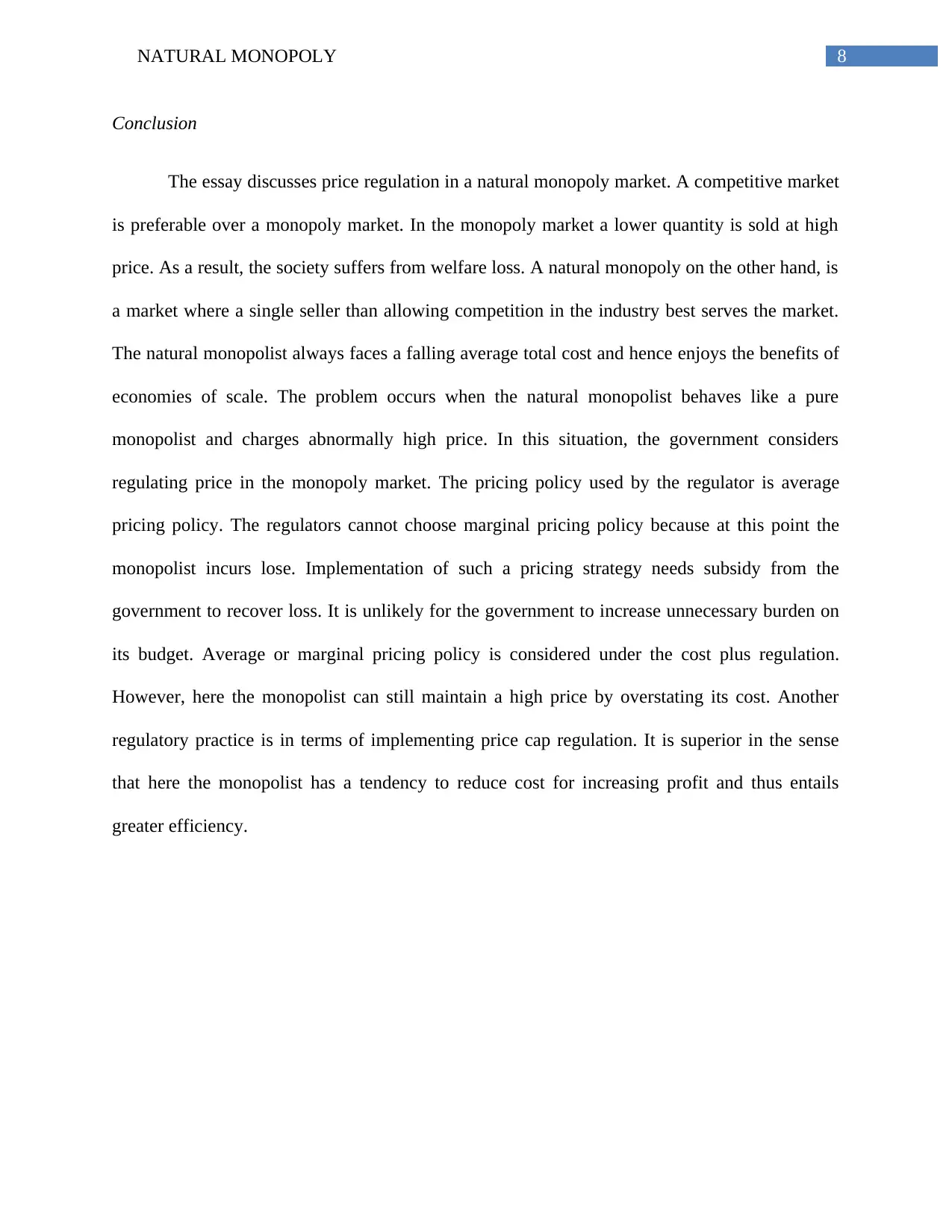
8NATURAL MONOPOLY
Conclusion
The essay discusses price regulation in a natural monopoly market. A competitive market
is preferable over a monopoly market. In the monopoly market a lower quantity is sold at high
price. As a result, the society suffers from welfare loss. A natural monopoly on the other hand, is
a market where a single seller than allowing competition in the industry best serves the market.
The natural monopolist always faces a falling average total cost and hence enjoys the benefits of
economies of scale. The problem occurs when the natural monopolist behaves like a pure
monopolist and charges abnormally high price. In this situation, the government considers
regulating price in the monopoly market. The pricing policy used by the regulator is average
pricing policy. The regulators cannot choose marginal pricing policy because at this point the
monopolist incurs lose. Implementation of such a pricing strategy needs subsidy from the
government to recover loss. It is unlikely for the government to increase unnecessary burden on
its budget. Average or marginal pricing policy is considered under the cost plus regulation.
However, here the monopolist can still maintain a high price by overstating its cost. Another
regulatory practice is in terms of implementing price cap regulation. It is superior in the sense
that here the monopolist has a tendency to reduce cost for increasing profit and thus entails
greater efficiency.
Conclusion
The essay discusses price regulation in a natural monopoly market. A competitive market
is preferable over a monopoly market. In the monopoly market a lower quantity is sold at high
price. As a result, the society suffers from welfare loss. A natural monopoly on the other hand, is
a market where a single seller than allowing competition in the industry best serves the market.
The natural monopolist always faces a falling average total cost and hence enjoys the benefits of
economies of scale. The problem occurs when the natural monopolist behaves like a pure
monopolist and charges abnormally high price. In this situation, the government considers
regulating price in the monopoly market. The pricing policy used by the regulator is average
pricing policy. The regulators cannot choose marginal pricing policy because at this point the
monopolist incurs lose. Implementation of such a pricing strategy needs subsidy from the
government to recover loss. It is unlikely for the government to increase unnecessary burden on
its budget. Average or marginal pricing policy is considered under the cost plus regulation.
However, here the monopolist can still maintain a high price by overstating its cost. Another
regulatory practice is in terms of implementing price cap regulation. It is superior in the sense
that here the monopolist has a tendency to reduce cost for increasing profit and thus entails
greater efficiency.
⊘ This is a preview!⊘
Do you want full access?
Subscribe today to unlock all pages.

Trusted by 1+ million students worldwide
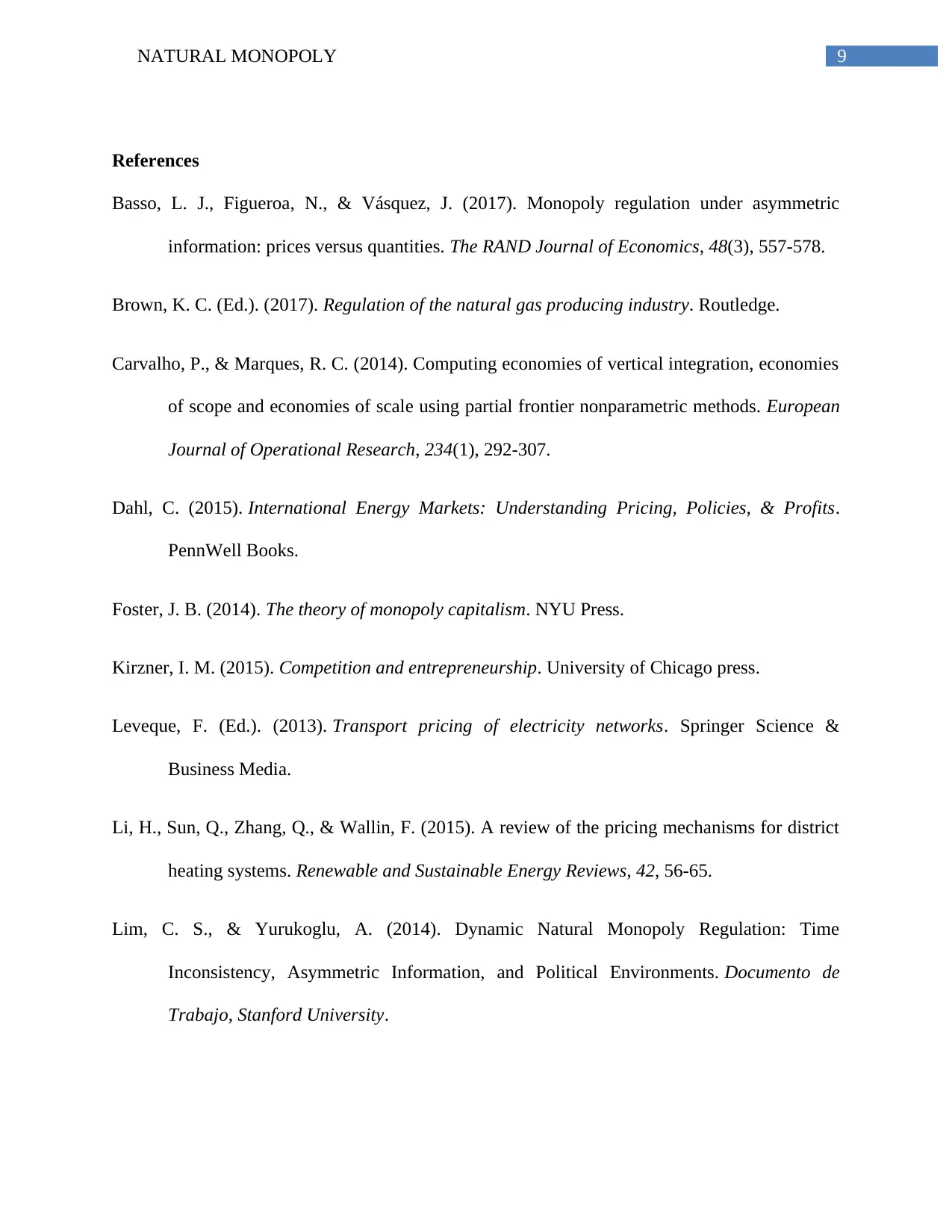
9NATURAL MONOPOLY
References
Basso, L. J., Figueroa, N., & Vásquez, J. (2017). Monopoly regulation under asymmetric
information: prices versus quantities. The RAND Journal of Economics, 48(3), 557-578.
Brown, K. C. (Ed.). (2017). Regulation of the natural gas producing industry. Routledge.
Carvalho, P., & Marques, R. C. (2014). Computing economies of vertical integration, economies
of scope and economies of scale using partial frontier nonparametric methods. European
Journal of Operational Research, 234(1), 292-307.
Dahl, C. (2015). International Energy Markets: Understanding Pricing, Policies, & Profits.
PennWell Books.
Foster, J. B. (2014). The theory of monopoly capitalism. NYU Press.
Kirzner, I. M. (2015). Competition and entrepreneurship. University of Chicago press.
Leveque, F. (Ed.). (2013). Transport pricing of electricity networks. Springer Science &
Business Media.
Li, H., Sun, Q., Zhang, Q., & Wallin, F. (2015). A review of the pricing mechanisms for district
heating systems. Renewable and Sustainable Energy Reviews, 42, 56-65.
Lim, C. S., & Yurukoglu, A. (2014). Dynamic Natural Monopoly Regulation: Time
Inconsistency, Asymmetric Information, and Political Environments. Documento de
Trabajo, Stanford University.
References
Basso, L. J., Figueroa, N., & Vásquez, J. (2017). Monopoly regulation under asymmetric
information: prices versus quantities. The RAND Journal of Economics, 48(3), 557-578.
Brown, K. C. (Ed.). (2017). Regulation of the natural gas producing industry. Routledge.
Carvalho, P., & Marques, R. C. (2014). Computing economies of vertical integration, economies
of scope and economies of scale using partial frontier nonparametric methods. European
Journal of Operational Research, 234(1), 292-307.
Dahl, C. (2015). International Energy Markets: Understanding Pricing, Policies, & Profits.
PennWell Books.
Foster, J. B. (2014). The theory of monopoly capitalism. NYU Press.
Kirzner, I. M. (2015). Competition and entrepreneurship. University of Chicago press.
Leveque, F. (Ed.). (2013). Transport pricing of electricity networks. Springer Science &
Business Media.
Li, H., Sun, Q., Zhang, Q., & Wallin, F. (2015). A review of the pricing mechanisms for district
heating systems. Renewable and Sustainable Energy Reviews, 42, 56-65.
Lim, C. S., & Yurukoglu, A. (2014). Dynamic Natural Monopoly Regulation: Time
Inconsistency, Asymmetric Information, and Political Environments. Documento de
Trabajo, Stanford University.
Paraphrase This Document
Need a fresh take? Get an instant paraphrase of this document with our AI Paraphraser
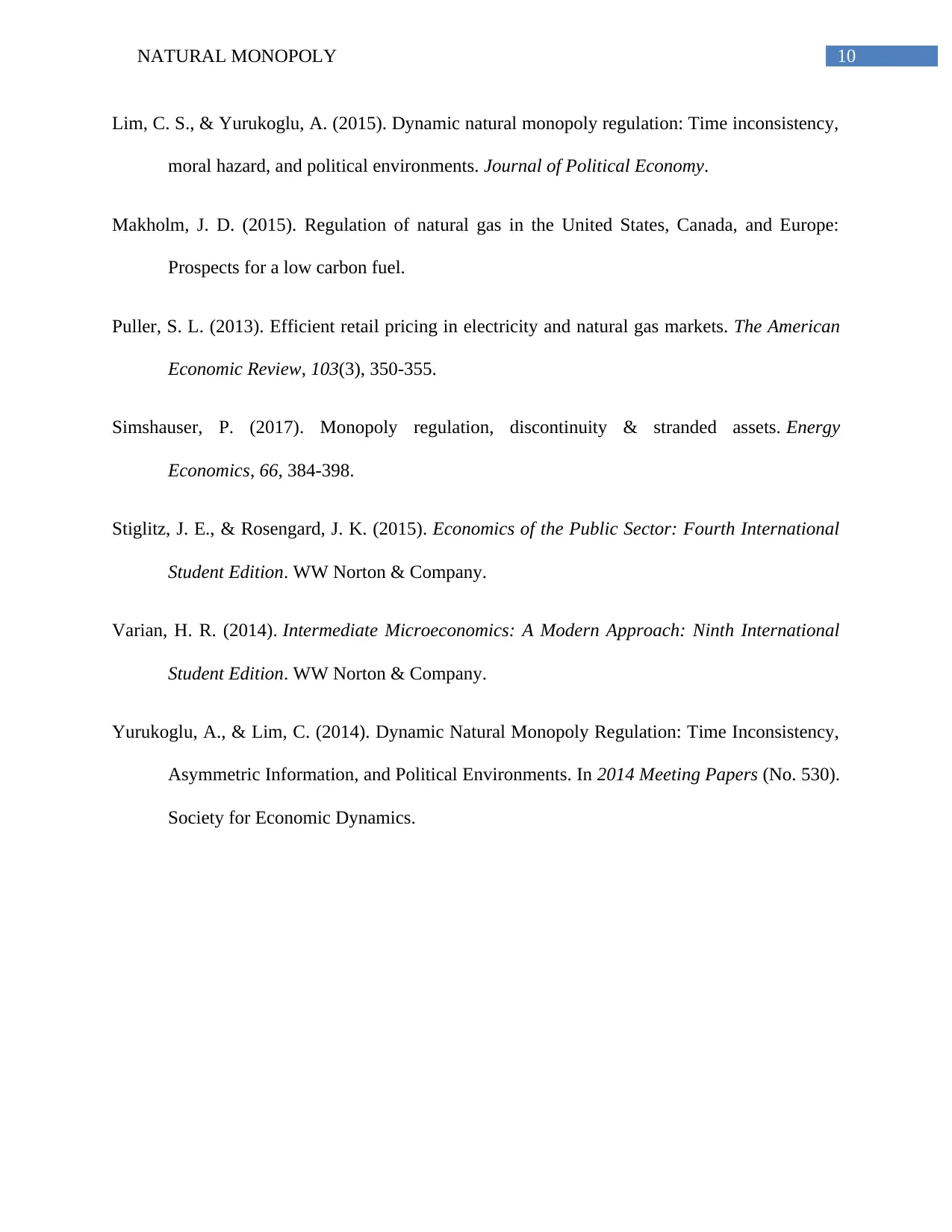
10NATURAL MONOPOLY
Lim, C. S., & Yurukoglu, A. (2015). Dynamic natural monopoly regulation: Time inconsistency,
moral hazard, and political environments. Journal of Political Economy.
Makholm, J. D. (2015). Regulation of natural gas in the United States, Canada, and Europe:
Prospects for a low carbon fuel.
Puller, S. L. (2013). Efficient retail pricing in electricity and natural gas markets. The American
Economic Review, 103(3), 350-355.
Simshauser, P. (2017). Monopoly regulation, discontinuity & stranded assets. Energy
Economics, 66, 384-398.
Stiglitz, J. E., & Rosengard, J. K. (2015). Economics of the Public Sector: Fourth International
Student Edition. WW Norton & Company.
Varian, H. R. (2014). Intermediate Microeconomics: A Modern Approach: Ninth International
Student Edition. WW Norton & Company.
Yurukoglu, A., & Lim, C. (2014). Dynamic Natural Monopoly Regulation: Time Inconsistency,
Asymmetric Information, and Political Environments. In 2014 Meeting Papers (No. 530).
Society for Economic Dynamics.
Lim, C. S., & Yurukoglu, A. (2015). Dynamic natural monopoly regulation: Time inconsistency,
moral hazard, and political environments. Journal of Political Economy.
Makholm, J. D. (2015). Regulation of natural gas in the United States, Canada, and Europe:
Prospects for a low carbon fuel.
Puller, S. L. (2013). Efficient retail pricing in electricity and natural gas markets. The American
Economic Review, 103(3), 350-355.
Simshauser, P. (2017). Monopoly regulation, discontinuity & stranded assets. Energy
Economics, 66, 384-398.
Stiglitz, J. E., & Rosengard, J. K. (2015). Economics of the Public Sector: Fourth International
Student Edition. WW Norton & Company.
Varian, H. R. (2014). Intermediate Microeconomics: A Modern Approach: Ninth International
Student Edition. WW Norton & Company.
Yurukoglu, A., & Lim, C. (2014). Dynamic Natural Monopoly Regulation: Time Inconsistency,
Asymmetric Information, and Political Environments. In 2014 Meeting Papers (No. 530).
Society for Economic Dynamics.
1 out of 11
Related Documents
Your All-in-One AI-Powered Toolkit for Academic Success.
+13062052269
info@desklib.com
Available 24*7 on WhatsApp / Email
![[object Object]](/_next/static/media/star-bottom.7253800d.svg)
Unlock your academic potential
Copyright © 2020–2025 A2Z Services. All Rights Reserved. Developed and managed by ZUCOL.





